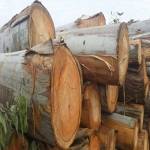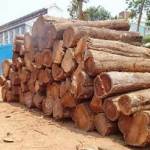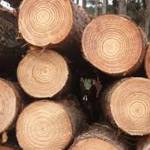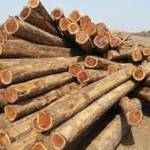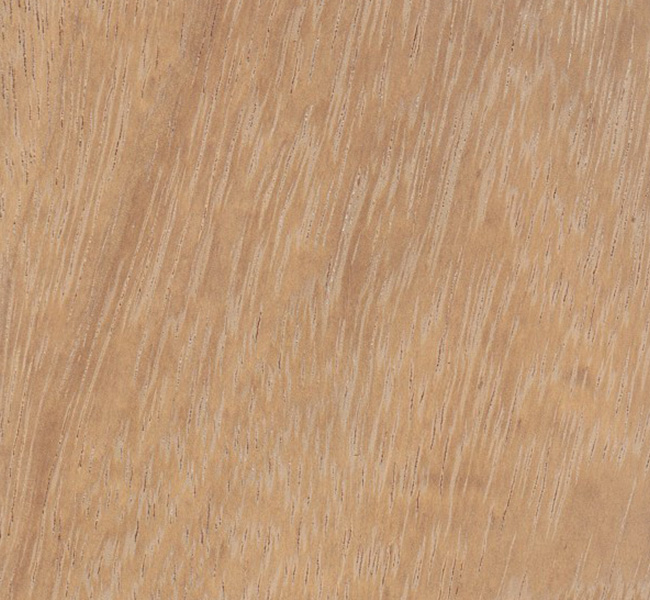
Iroko
- Common Name(s): Iroko
- Scientific Name: Milicia excelsa, M. regia (syn. Chlorophora excelsa, C. regia)
- Distribution: Tropical Africa
- Tree Size: 100-130 ft (30-40 m) tall, 3-5 ft (1-1.5 m) trunk diameter
- Average Dried Weight: 41 lbs/ft3 (660 kg/m3)
- Specific Gravity (Basic, 12% MC): .55, .66
- Janka Hardness: 1,260 lbf (5,610 N)
- Modulus of Rupture: 12,700 lbf/in2 (87.6 MPa)
- Elastic Modulus: 1,360,000 lbf/in2 (9.38 GPa)
- Crushing Strength: 7,840 lbf/in2 (54.0 MPa)
- Shrinkage: Radial: 2.8%, Tangential: 3.8%, Volumetric: 8.8%, T/R Ratio: 1.4
Color/Appearance: Heartwood is usually a yellow to golden or medium brown, with color tending to darken over time. Pale yellow sapwood is clearly demarcated from the heartwood.
Grain/Texture: Iroko has a medium to coarse texture, with open pores and an interlocked grain.
Endgrain: Diffuse-porous; large to very large pores in no specific arrangement, very few to few; solitary and radial multiples of 2-3; tyloses common; growth rings indistinct; medium rays visible without lens, spacing wide to normal; parenchyma banded, paratracheal parenchyma vasicentric, aliform (winged and lozenge), and confluent.
Rot Resistance: Iroko is very durable, and is resistant to both rot and insect attack; it’s sometimes used as a substitute for Teak.
Workability: Generally easy to work, with the exception of its interlocked grain, which may cause some tearout during surfacing operations. Also, deposits of calcium carbonate are sometimes present, which can have a significant dulling effect on cutters. Iroko glues and finishes well.
Odor: No characteristic odor.
Pricing/Availability: Iroko is imported and available for a moderate price. Veneer can also be seen for sale, and is likewise affordably priced.
Sustainability: This wood species is not listed in the CITES Appendices, but is on the IUCN Red List. It is listed as vulnerable due to a population reduction of over 20% in the past three generations, caused by a decline in its natural range, and exploitation.
Common Uses: Veneer, flooring, furniture, cabinetry, boatbuilding, turned items, and other small specialty wood items.
Comments: Given the high prices of genuine Teak, Iroko could be considered a low-cost alternative. The wood is stable, durable, and has an overall look that somewhat resembles Teak

Mohogny Wood
Available Sizes: 50mm 75mm
Properties and Characteristics of Mahogany Timbe
Mahogany is widely used in the furniture and cabinet building industry. It is made into plywood and all kinds of trim. Mahogany timber is grown and farmed in almost every continent, making it one of the most prolific of all the wood species. It has subtle differences depending on where it grows.
Size
Mahogany trees are among the biggest of all trees regularly harvested. When cut into timber, it’s not unusual for individual boards to be well over 24 inches in width. The circumference of the tree is usually not compromised by large knots, therefore the individual pieces of lumber are also long and straight. Mahogany trees yield more timber per running foot than almost any other specie.
Stability
Wood stability characteristics depend on a few basic factors, grain and moisture content. Hard grain is the visible lines in the wood. Soft grain is the wood between the grain lines. Mahogany timber it is very stable due to its close, straight-grain pattern and lack of soft grain. When properly kiln dried to a moisture content of about 14 percent, mahogany timber will remain stable and resist warping or twisting for many years.
Color
Depending on where the mahogany is grown, it can range from gray to brown, to red, to orange or a blend of all three.
Hardness
Mahogany timber ranks about 6 on a 1-to-10 hardness scale, with 10 being the hardest. Woodworkers consider it one of the softer of all the hardwoods commonly in use, and prize it for its tool-friendliness, it cuts and machines easily. It has a slightly flexible quality that makes it bend without splintering or shattering like other hardwoods that are more brittle than mahogany.

